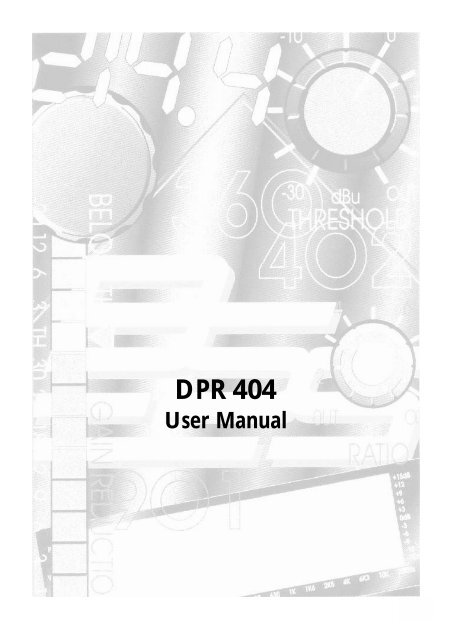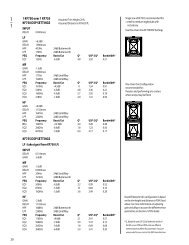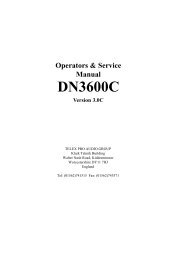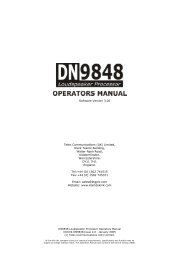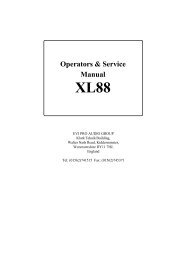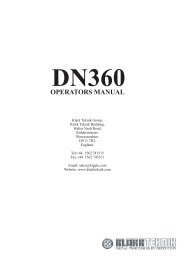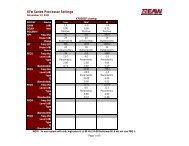BSS DPR-404 Quad Compressor - Allstar Audio Systems, Inc. - Home
BSS DPR-404 Quad Compressor - Allstar Audio Systems, Inc. - Home
BSS DPR-404 Quad Compressor - Allstar Audio Systems, Inc. - Home
You also want an ePaper? Increase the reach of your titles
YUMPU automatically turns print PDFs into web optimized ePapers that Google loves.
Mains Power connection5.0 Mains Power ConnectionVoltage: The <strong>DPR</strong>-<strong>404</strong> operates on either 120 or 240 volt supplies. Use thevoltage selector switch to choose the required voltage setting. (See Figure8.1).Frequency: Both 60Hz and 50Hz are acceptable.Fig 5.1 Mains fuse onrear panel.8Grounding: The <strong>DPR</strong>-<strong>404</strong> must always be connected to a 3-wire grounded('earthed') AC outlet. The rack framework is assumed to be connected to thesame grounding circuit. The unit must NOT be operated unless the powercables ground ('earth') wire is properly terminated - it is important for personalsafety, as well as for proper control over the system grounding.AC Power Fusing: The incoming mains power is fused within the <strong>DPR</strong>-<strong>404</strong> bythe fuse holder mounted on the rear panel. If it needs to be replaced it mustbe properly rated as:20mm T160mA for 240v ACT250mA for 120v ACIt is most important for continued safety that this specification is adhered to,and you will have found that spare fuses of this rating are supplied togetherwith your unit and manual. It is very unlikely that this fuse will fail duringnormal use, and must be treated with some caution as to the cause, if itshould do so. One of the most likely reasons will be following the incorrectsetting of mains voltage switch on the rear panel. Another reason can be theinadvertent connection of line to line rather than line to neutral phasevoltages when using a three phase power connection. In either case, theinternal transient suppressors (VDRs) can become damaged. If so, they’llconsistently blow replacement fuses. You can be assured that they haveprotected your unit from damage, that the cost of replacement is small andthat the VDR’s demise has saved the much higher cost of ‘blowing up’ anentire unit. If blown, the VDRs will need removal to allow further use of yourunit.If you believe this has happened, please refer to section 13.1 for the removaland replacement procedure. They should be replaced as soon as possible toensure continued protection.
Power ON: This is indicated the green 'ON' LED located under the CH 'IN'switches. If this LED is not lit when power is connected and the 'POWER'switch is depressed, see section 16.9
Getting to know the <strong>DPR</strong>-<strong>404</strong>Fig 6.1 Front PanelFig 6.2 Rear Panel10
All numbers in bubbles refer to Section numbers.11
<strong>Audio</strong> connections7.0 <strong>Audio</strong> connectionsThe <strong>DPR</strong>-<strong>404</strong> audio inputs are RFI filtered and electronically balanced, withthe outputs electronically balanced and floating. They are designed to operateat any signal level up to +20dBu and will drive into loads of 600 ohms orgreater. They will be ‘fuss free’, regardless of your installation’s complexity.Note that pin 1 of the input XLR is not connected to ground.7.1 Balancedwiring7.2 Unbalancedwiring7.3 Ground loopcontrolWhether your system is wired to a ‘pin 3 hot’ or a ‘pin 2 hot’ convention willnot matter as long as your wiring to both the input and output 3 pin XLRconnectors are the same . As is common with all other <strong>BSS</strong> equipment of thistype, we follow the convention of ‘screen goes forward with the signal’. Inputcable screening therefore needs to be derived from the signal source end aspin 1 is ground lifted for the inputs. You should use high quality audio cablewith 2 cores + screen for low noise and reliability, and to sidestep potentialproblems.If the equipment driving the <strong>DPR</strong>-<strong>404</strong> has unbalanced outputs then you willneed to add a wire jumper such that the screen connection on Pin 1 of theXLR is shorted to either Pin 2 or Pin 3, depending on the wiring convention ofthe unbalanced equipment. If the equipment being connected to the <strong>DPR</strong>-<strong>404</strong>outputs have only unbalanced inputs, then we recommend that you still use abalanced (i.e. 2 core shielded) cable. The interconnecting cable should haveit’s screen grounded by pin 1 of the <strong>DPR</strong>-<strong>404</strong> output, the pin 3 output shouldbe connected the unbalanced input 0v ground, and the pin 2 output should beconnected to the live input. There should be no connection between the cablescreen and the 0v/chassis ground connection of the unbalanced equipment.Strict adherence to this will help to eliminate potential ground loop hums byremoving signal currents from the cable screen.Adherence to the wiring conventions noted above within a fully balancedsignal system will yield the best possible results with none of the problemsnormally associated with interconnected audio equipment. Wherever possible,cable screens should not be connected to any signal pin, but rather left toperform a cable shielding function only. Where it is not possible to control allof the external cabling, it might become necessary to have the internalelectronic ground of your unit separated from the case safety ground. Provisionis made internally within the <strong>DPR</strong>-<strong>404</strong> to separate these two grounds at aconvenient point, or to add a suitable impedance network as part of a housesystem requirement. Under no circumstances should the safety ground wire beremoved from the mains AC power connector as an interim measure toachieve similar results. Please refer to section 13.2, for information on thisprocedure.12
7.4 LinkedoperationFor stereo program processing, channels 1 and 2 can be linked together byselecting the LINK switch on channel 2. Channel 1 will assume the masterrole, such that threshold, ratio, attack and release for channel two are equal toand controlled by channel 1 with the side chain controlling signal being themono sum of both channels. This facility is also repeated for the second pair,channels 3 and 4. HF de-essing is similarly treated, when using the LINKmode. When processing stereo program, it is always important to maintain thestereo imaging and prevent an audible shift in positioning. Channels 1 and 2plus channels 3 and 4 can be selected to work as linked stereo pairs enablinga stereo program to be successfully processed. Selecting the LINK switch onchannel 2 (or channel 4) re-connects the side chain circuitry such thatchannel 1 (or channel 3) now derives the controls voltages for the summedleft/right program signal and applies it equally to both channels. Channel 1 (orchannel 3) is called the master, whilst channel 2 (or channel 4) the slave. Themaster channels threshold, attack, release and ratio controls will now controlboth master and slave channels simultaneously, with those on the slavechannel becoming inoperative.13
Controls8.0 Controls8.1 INWhen depressed the processing is engaged and the green LED lights inconfirmation. When released, processing is disabled, the LED is off and theincoming signal passes to the output unchanged and at unity gain.8.2 GainOutput level control used to restore signal after processing, providing ÿ 20dBof adjustment range. Operation of this control has no affect on thresholdsetting and should the output signal level approach +20dBv the adjacent redLED will illuminate to indicate onset of clip.8.3 RatioUsed to set the scale factor for gain reduction, providing a range of 1:1 to20:1. Low ratios have soft knee developing into hard limit at 20:1. When setto ‘out’, no compression will occur even if signal level is exceeding threshold.Sets the operating level at which compression will occur, adjustable from+20dBv to -30dBv. Signal level in relation to threshold point is shown on thegain reduction meter, such that when the TH LED is passed, compression willcommence.14
8.4 Attack/ReleaseWith the switches released, the function is automatically set and is programrelated, such that it follows the signal requirements for general vocal and mixprogram signals. (It closely follows the ‘auto’ mode on the <strong>DPR</strong>-402 unit).When depressed, the function is again automatically set and program relatedbut is scaled to suit more transient program material such as percussion.8.5 Below TH meter Signal indicator showing the input signal level relative to the point at whichcompression will commence. Anticlockwise rotation of the threshold controlbrings the input signal into the compression window and determines thethreshold point. The half illuminated orange LED indicates the threshold point,above which, compression occurs.8.6 Gain reductionmeterShows the amount of gain reduction in dBs, being the difference between theinput and output signal levels. The scale increases from right to left such thatat all times the illuminated LEDs show the actual amount of gain reductionused, whilst the non illuminated LEDs give an indication of the range ofreduction left from the maximum of 30dB.15
Rear panel controls8.11 Main powerfuse20mm, T160mA for 240v AC voltage setting and T250mA for 120v AC voltagesetting9.0 Rear panel controls9.1 Mains voltageselector switchAllows operation from 90v-130v or 190v-250v 50/60Hz AC mains voltage.9.2 Mains powerswitchTurns the unit on/off.9.3 Mains voltageselector switchAllows operation from 90V-130V or 190V-250V 50/60Hz AC mains voltage.17
Rear panel controls9.4 External sidechain insertOffers a line level insertion point, on an RTS jack, into the control side chain.Connections are: Ring: Signal output from 470 source.Tip: Return input to 10k.Sleeve: 0v ground.9.5 Electronicallybalanced inputMaximum input is +20dBu into 10kohms.The pin connections are: Pin 1: Open circuit/no connection.Pin 2: Hot (+).Pin 3: Cold (-).Note: Transformer balancing is available as an option.9.6 Electronicallybalanced andfloating outputMaximum output is +20dBu into 600ohms.The pin connections are: Pin 1: Ground/Chassis.Pin 2: Hot (+).Pin 3: Cold (-).Note: Transformer balancing is available as an option.18
<strong>Compressor</strong>s and Limiters10.0 <strong>Compressor</strong>s and Limiters10.1 The need forGain ControlThe human ear excels in its ability to detect an extremely wide range ofsound levels. These can range from the quietest whisper to the roar of a jetaircraft. When we attempt to reproduce this large range (dynamic range) ofsounds with amplifiers, tape recorders or radio transmitters, we run into one ofthe fundamental limitations of electronic or acoustic equipment. In somecases, such as amplifiers, the dynamic range available is quite good.However, equipment such as tape recorders and radio transmitters have arestricted usable dynamic range.Fig 10.1 DynamicRangeWhat limits the available dynamic range of this equipment is its inherentnoise floor at the bottom end, and the maximum input signal resulting in anacceptable amount of distortion at the upper end (See figure 1.2). The usabledynamic range sits in between these two limits, and it is common practice tooperate a piece of equipment at a level that is somewhat below the upperdistortion point, leaving a margin of safety for the unexpected transientloudness peaks present in program material. The safety margin is known asheadroom, and is generally in the range of 10 to 20dB. Lowering the standardoperating level to increase headroom helps distortion, but moves the averageprogram level nearer to the noise floor, thereby compromising the signal tonoise performance.19
<strong>Compressor</strong>s and LimitersFig 10.2 Operating leveland HeadroomIt therefore becomes apparent that to get the most out of an audio system, thestandard operating level must be kept as high as possible without riskingdistortion.One solution to this problem is for the operator of the equipment to becontinuously monitoring the program, and manually adjusting the gain to suitthe moment. When the program is quiet, the gain can be increased, and whenthe program is loud the gain can be reduced. However, in most types ofprogram there are instantaneous short duration level peaks or transients, whichwould be difficult to anticipate and impossible to respond to in the requiredtime. Even a sound engineer with the quickest reflexes could not bring thegain knob or fader down quickly enough.The need therefore arises for a fast acting automatic gain controlling devicewhich will track the program material constantly, and which will alwaysadjust the gain to maximise the signal to noise performance without incurringdistortion. This device is called a compressor or limiter, and is one part of the<strong>DPR</strong>-<strong>404</strong>.10.2 <strong>Compressor</strong>sand Limiters<strong>Compressor</strong>s and limiters have closely related effects, and in general a limiterwill reduce gain very strongly once a certain level has been reached, whereasa compressor will act gently, but over a much wider range of volume levels.A limiter will continuously monitor program levels, but only commence toreduce gain once the level has exceeded a preset amount. This point is calledthe threshold level. Any program level in excess of the threshold willimmediately be reduced to this threshold level.A compressor will also continuously monitor the program and has a thresholdlevel. However, program signals in excess of this threshold will beprogressively reduced by an amount (ratio) depending on the degree to whichit initially exceeds the threshold. Generally, threshold levels for compressorsare set below the normal operating level to allow them to reduce the dynamicrange of the signal gradually, so that they are acceptable to followingequipment. For limiters, the threshold point will be set above the operatinglevel in order to provide a maximum level for signals to following equipment.20
In the <strong>DPR</strong>-<strong>404</strong>, gain reduction is achieved by using a proprietary subtractivecircuit which minimises signal degradation and has a maximum attenuatingrange of 30dB. The THRESHOLD control is used to position the input programsignal into the window of operating range for the circuit. Rotating the controlanticlockwise from the ‘out’ position will bring the signal onto the BELOW THmeter. Gain reduction will commence once the dimly lit TH LED isexceeded, and the actual amount of reduction in gain shows on the GAINREDUCTION METER, calibrated in dBs. The RATIO control is used to scalethe reduction effect once threshold is exceeded, and the scale numbers relateto the amount of program signal, in excess of threshold, that will cause a 1dBincrease in output level. For general compression a ratio of between 2:1 and4:1 is an optimum starting point. For limiting a ratio of between 10:1 and 20:1is to be used.The response of the <strong>DPR</strong>-<strong>404</strong> to signals above threshold is further defined bythe ATTACK and RELEASE controls. These control how quickly gain reductionoccurs and, following signal level dropping below threshold, how slowly thegain reduction is removed and unity gain restored. It is important that thesecontrols are set to suit the particular program envelope and the <strong>DPR</strong>-<strong>404</strong> isprovided with two automatic ranges that are designed to carefully optimisethese times to the signal. With the switches in their released position, thetimes are set to work within a range typical of vocals, mix program materialand other non transient sources. When compressing very fast percussivesounds it is recommended that the fast auto modes are selected by depressingthe switches. Any combination can be used and it is best that the optimumsetting be found by listening for the desired effect. In general too fast anattack will cause high frequency distortions and clicking sounds, whereas toofast a release will give level pumping effects and low frequency distortions.Because compression is a gain reducing effect, the output signal is often at alower level than normal.The GAIN control, scaled in dBs, is provided to restore the output signal level.It is positioned after the reduction process and therefore has no effect on thethreshold setting. The associated red LED will give an indication that outputlevel is approaching the maximum operating level for the channel. Shouldyou wish to bypass the compress ion effect, releasing the IN switch willrestore the output signal to that of the input. The green LED illuminates toshow when the channel is active. The LED metering remains active even inthe bypassed mode, so that some initial setting up can be done beforeselecting the IN.21
The effect of Compression11.0 The effect of Compression on sound11.1 CompressionConsider an input signal which is applied to two units, one having itsthreshold point set 10dB higher than the other. Since the compressor onlyaffects signals that exceed the threshold level, the signal with the lowerthreshold applied will be more affected than the other. Referring to figuresFig 11.1a High thresholdlevelFig 11.1b Lowerthreshold level2.2a & b, assuming that all other controls on both channels are set identicallywith gains equalised, it is immediately apparent that the signal processed withthe higher ratio is said to have been limited, whereas the signal with thelower ratio is said to have been compressed.Fig 11.2a Effect ofcompression with highthresholdFig 11.2b Effect ofcompression with lowerthreshold22
Comparing the input and output waveforms for the compressed mode, theloudest portions of the signal have been effectively decreased in level, and ifthe gain control is adjusted to compensate for this, the quieter portions will beincreased. The net effect, therefore, is for both ends of the dynamic spectrumto be pushed (or squeezed) towards each other. This squeezing effect ofcompression is important to remember, and provides a major differencebetween compression and limiting. I.e. Limiters do not make-up the gainreduction.The range provided by the <strong>DPR</strong>-<strong>404</strong> on its ratio and release controls issufficient to allow its use either as a compressor or limiter. For limiterapplications, the release fast switch should generally be out.11.2 Attack,Release and RatioAttack is the amount of time that elapses before the compressor begins toattenuate the output level after the threshold point has been exceeded. Forsounds such as a snare drum or hand clap, fast attack is desirable so that thecompressor responds in time to control the peaks.Release is the amount of time taken for the compressor to return to normalgain after the input signal has fallen BELOW the threshold point.Ratio determines the ratio of change on output level to changes in input levelfor all signals that exceed the threshold. Returning to section 1.1 where theidea of manual controlling the level of the program was discussed, theoperator would reach over and turn down the volume if signal levels wereapproaching distortion. At this point he now has an option: Either reduce thelevel so that there is nothing exceeding his desired maximum level, or reducethe level by a small amount so that his output is slightly greater than that ofhis preferred maximum but not as loud as it would have been if no action hadbeen taken. This action is known as the ratio. A ratio of 1:1 indicates that theoutput will linearly track the input level of the threshold. i.e. For every 1dB ofinput over the threshold point, there will be 1dB of output. A ratio of 2:1indicates that for every 2dB of input level above the threshold, there will be acorresponding increase of 1dB in the output level. A ratio of 10:1 indicatesthat for every increase of 10dB of input level, there will be a correspondingincrease of 1dB in the output level, and so on. A ratio of infinity:1 indicatesthat no matter how loud the input signal goes above the threshold, the outputwill remain constant at the threshold point. It is worth noting that a hard orinfinite ratio limit has applications in some specialised situations, but ingeneral it is neither appropriate nor necessary, and is likely to cause noticableside effects in the sound.23
De-essing and Peak Limiter11.3 De-essingA common problem encountered when amplifying or recording the humanvoice is the large amount of high frequency energy heard as the sibilant (Sss)sound. These sounds can reach levels considerably greater than the normalvoice level, and can result in signal break-up or distortion. It is possible tocontrol these sounds by using a compressor which is specially configured torespond to, and only reduce, these high frequencies. Selective high frequencycompression is generally called de-essing, as it removes the high frequencySss content from the program. The <strong>DPR</strong>-<strong>404</strong> de-essing circuitry is speciallyconfigured to enable precise selection and control of high frequencysibilance. The variable FREQ control tunes not only high pass filters in thecontrolling side chain but also in the main subtracter so that gain reductionwill only affect the high frequencies, leaving the rest of the programunprocessed.Fig 12.1 Effect ofde-essing on outputIn use, the frequency control is adjusted such that the filter is capturing thecorrect high frequency sibilance, and the DE-ESS level control, working like athreshold control, is used to set the correct degree of gain reduction. Theassociated green LED indicates the start of de-essing action, whilst the redLED indicates the maximum 10dB compression. The dynamic attack andrelease settings are automatically adjusted by the circuitry depending on theprogram type.24
Specifications12.0 SpecificationsInput section12k ohm electronically balanced, +20dBu (+20dBv) maximum input level via a 3 pin male XLRcable plug. Common Mode rejection: > -50dB, 20Hz to 20kHzInput sectionElectronically balanced and floating, capable of driving +20dBu (+20dBv) into 600 ohms or greater via an XLRfemale cable plug.Frequency response:+/- 0.5dB, 20Hz to 20kHz (Low pass at 29kHz)Noise:
SpecificationsSide chain insert:Rear panel RTS jack accesses side chain for inserting other equipment at linelevel. Connections are: Ring: Signal output from 470 ohms sourceTip: Return input into 10kohmsSleeve: 0v groundPower: AC 50/60Hz 120v/240v switched externally giving operation range of 90-132vand 180-264v. Anchored 2m power cordSize:482 x 44 x 282mm19” x 1U x 11.10"Weight:4.1kg gross shippingOptionsTransformer balancing for input and output.26
!!! CAUTION - Important Notes !!!SERVICE SECTION13.0 Service Section13.1 TransientsuppressorreplacementThe primary of the input transformer is protected against high voltage spikeinterference by two voltage dependent resistors (VDR). These provide amomentary short circuit to voltage peaks in excess of the normal powervoltage rating.Should the <strong>DPR</strong> <strong>404</strong> be inadvertently connected to 3-phase line/line voltagesor to 240V when selected for 120V, or any other incorrect voltage, thesesuppressors are likely to fail in a short circuit mode. This will be demonstratedby repeated mains fuse failure at power up.Even in this case of extreme over-voltage, the <strong>DPR</strong> 504 is protected againstfailure, and the simple removal of the damaged suppressors will allow the unitto be used again. It is important, however, that they are replaced immediatelyto ensure continued protection.Before attempting to remove the damaged suppressors, ensure that the unit isunplugged and totally isolated from any power supply.Figure 13.1 shows the suppressors location on the voltage selector board.Fig 13.1 Suppressorlocation!!! WARNING - Refer all servicing to qualified service personnel !!!Risk of electric shock if the unit is opened.<strong>BSS</strong> <strong>Audio</strong> accepts no responsibility for injurysubsequent to opening of the unit.27
!!! CAUTION - Important Notes !!!SERVICE SECTION13.2 Separatingsignal and chassisgroundIn some installations, it might be necessary to separate the electronic signal0V ground from the chassis ground to avoid earth loops.Since both the inputs and outputs of the <strong>DPR</strong> 504 are balanced, correctconnector wiring should be alleviate this problem. Prior to continuing with thisprocedure, it is recommended that you recheck all audio wiring forcorrectness.Should it be necessary, then the simple removal of an internal wire linkaccomplishes this task. Refer to figure 13.2 for the location of this wire link.To remove the wire link, you will need to remove the top cover of the unit,and then remove the top PCB, and 4 LED PCBs. The chassis link point willthen be accessible, located between C512 and C502 labels (white silk screen)on the main PCB.On no occasion should the incoming safety ground wire be disconnected fromthe line cord or from the internal chassis connection as an alternative to thisprocedure.Fig 13.2 Chassis linklocation28!!! WARNING - Refer all servicing to qualified service personnel !!!Risk of electric shock if the unit is opened.<strong>BSS</strong> <strong>Audio</strong> accepts no responsibility for injurysubsequent to opening of the unit.
Warranty Information14.0 Warranty InformationIMPORTANTWhen sold to an end user by <strong>BSS</strong> <strong>Audio</strong> or a <strong>BSS</strong> <strong>Audio</strong> Authorised Reseller,this unit is warranted by the seller to the purchaser against defects inworkmanship and the materials used in its manufacture for a period of oneyear from the date of sale.Faults arising from misuse, unauthorised modifications or accidents are notcovered under this warranty. No other warranty is expressed or implied.If the unit is faulty it should be sent to the seller of the equipment, in itsoriginal packaging with shipping prepaid. The unit will be returned to youwhen the repair has been completed. If the unit was purchased witin theEuropean Union, you may, as an alternative, return the unit to any other <strong>BSS</strong>distributor in the European Union.You should include a statement listing the faults found. The unit’s serialnumber must be quoted in all correspondence relating to a claim.We recommend that you record your purchase information here for futurereference.Dealer Name:Dealer Address:Post/Zip Code:Dealer Phone No.:Dealer Contact Name:Invoice/Receipt No.:Date of Purchase:Unit Serial Number:In keeping with our policy of continued improvement, <strong>BSS</strong> <strong>Audio</strong> reserves theright to alter specifications without prior notice.The <strong>DPR</strong>-<strong>404</strong> was designed and developed by <strong>BSS</strong> <strong>Audio</strong>, Hertfordshire,England.Phone (+44) (0)1707 660667. Fax (+44) (0)1707 660755.World Wide Web address: http://www.bss.co.uk29
IndexRelease time 21SSpecifications 23TThreshold 14Transient suppressorreplacement 25UUnpacking 6WWarranty Info. 2731
User Notes32
User Notes33


